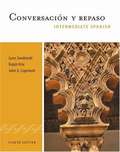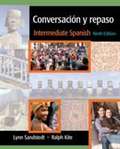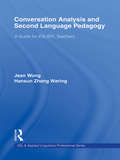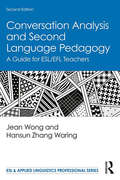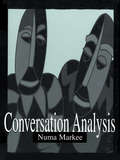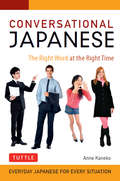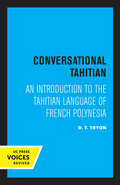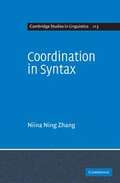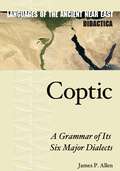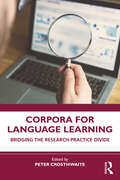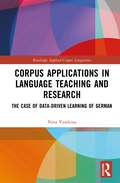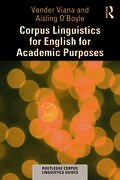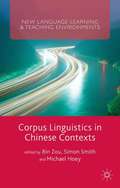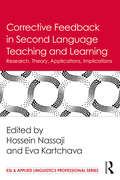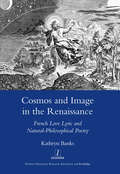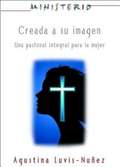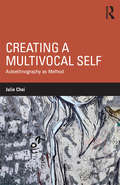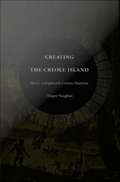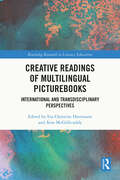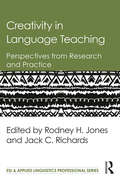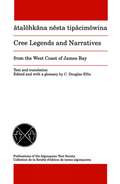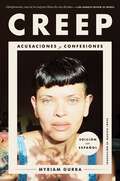- Table View
- List View
Conversacion y Repaso: Intermediate Spanish (8th edition)
by Ralph Kite Lynn A. Sandstedt John G. CopelandCONVERSACIoN Y REPASO, Eighth Edition, is the core text of the Intermediate Spanish Series that has gained the reputation as the most complete grammar syllabus with in-depth explanations, while its three book format allows greater flexibility for any intermediate Spanish program.
Conversación y repaso: Intermediate Spanish
by Lynn Sandstedt Ralph KiteCONVERSACI & ÓN Y REPASO, Ninth Edition, is part of a three-volume INTERMEDIATE SPANISH series that gives you a thorough review of grammatical structures and helps you communicate with confidence in Spanish. You'll find clear, easy-to-understand explanations of grammar topics in plain English that you can follow on your own. You'll quickly learn to use and develop reading, writing, speaking, and listening skills through a variety of activities and exercises for conversation. Plus, the book's many study resources, including Heinle iRadio's MP3-ready, Spanish-language tutorials for pronunciation and grammar, will help you succeed in the course!
Conversation Analysis and Second Language Pedagogy: A Guide for ESL/ EFL Teachers (ESL & Applied Linguistics Professional Series)
by Hansun Zhang Waring Jean WongConversation and speaking skills are the key building blocks for much of language learning. This text increases teachers’ awareness about spoken language and suggests ways of applying that knowledge to teaching second-language interaction skills based on insights from Conversation Analysis (CA). Conversation Analysis and Second Language Pedagogy: reviews key CA concepts and findings directly connects findings from CA with second language pedagogy presents a model of interactional practices grounded in CA concepts includes numerous transcripts of actual talk invites readers to complete a variety of tasks to solidify and extend their understandings features a useful collection of practical teaching activities. The time is ripe for a book that blends conversation analysis and applied linguistics. This text takes that important step, extending the reaches of these once separate academic fields. Assuming neither background knowledge of conversation analysis nor its connection to second language teaching, it is designed for courses in TESOL and applied linguistics and as a resource for experienced teachers, material developers, and language assessment specialists seeking to update their knowledge and hone their craft.
Conversation Analysis and Second Language Pedagogy: A Guide for ESL/EFL Teachers (ESL & Applied Linguistics Professional Series)
by Jean Wong Hansun Zhang WaringNow in its second edition, this volume offers a strong synthesis of classic and current work in conversation analysis (CA), usefully encapsulated in a model of interactional practices that comprise interactional competence. Through this synthesis, Wong and Waring demonstrate how CA findings can help to increase language teachers’ awareness of the spoken language and suggest ways of applying that knowledge to teaching second language interaction skills. The Second Edition features: Substantial updates that include new findings on interactional practices Reconceptualized, reorganized, and revised content for greater accuracy, clarity, and readability Expanded key concepts glossary at the end of each chapter New tasks with more transcripts of actual talk New authors' stories The book is geared towards current and prospective second or foreign language teachers, material developers, and other language professionals, and assumes neither background knowledge of conversation analysis nor its connection to second language teaching. It also serves as a handy reference for those interested in key CA findings on social interaction.
Conversation Analysis: Capturing Transitions In The Classroom (Second Language Acquisition Research Series #295)
by Numa MarkeeConversation analysis is a methodology that originated over three decades ago as a sociolinguistic approach but has since been adopted by scholars in a variety of other areas, including applied linguistics and communication. It is of great utility in second language acquisition research for its demonstrations of how micro-moments of socially distributed cognition instantiated in conversational behavior contribute to observable changes in the participants' states of knowing and using a new language. This volume describes the methodology in detail, discusses its relevance for current theories of SLA, and uses two extended examples of conversational analysis to show how learners succeed or fail at the job of learning the meaning of a word or phrase in conversational context. This book is one of several in LEA's Second Language Acquisition Research Series dealing with specific data collection methods or instruments. Each of these monographs addresses the kinds of research questions for which the method/instrument is best suited, its underlying assumptions, a characterization of the method/instrument and extended description of its use and problems associated with its use. For more information about these volumes, please visit LEA's Web site at www.erlbaum.com
Conversational Japanese
by Anne KanekoThis book is a user-friendly language guide for basic spoken Japanese.More than a phrase book, Conversational Japanese provides basic material for practical day-to-day communication. Through hundreds of example sentences and dialogs, as well as thorough explanations of the customs involved, learners will know what to say and do when:Meeting new peopleReserving a hotel roomBuying a train ticketOffering a giftWriting email, business letters, cards and thank-you notesThis book is about communication. As we all know communication is more than just language. Our body language is just as important, as we all bring a host of personal and cultural baggage to each conversation we have. To communicate successfully in another culture and speak Japanese we need more than the bare bones of the language.Unlike most language books, Conversational Japanese does not restrict the use of kanji (Chinese characters), and the sentences are written in the usual Japanese combination of kana (hiragana and katakana) and kanji. Since learning kanji is a difficult task, Conversational Japanese includes romanji (Romanized Japanese) for each word or phrase. As you progress, using kanji and kana will become easier to remember and you should be able to pick up new kanji over time.
Conversational Tahitian: An Introduction to the Tahitian Language of French Polynesia
by D. T. TryonThis title is part of UC Press's Voices Revived program, which commemorates University of California Press’s mission to seek out and cultivate the brightest minds and give them voice, reach, and impact. Drawing on a backlist dating to 1893, Voices Revived makes high-quality, peer-reviewed scholarship accessible once again using print-on-demand technology. This title was originally published in 1970.
Conversations of the Mind: The Uses of Journal Writing for Second-Language Learners
by Rebecca William MlynarczykAsking students to write journals that reflect on their learning has become a widespread pedagogical practice in recent years. However, the scholarly literature does not address certain key questions about how journal writing aids learning: * Is there something inherent in journal writing that encourages students to write reflectively? * What psycholinguistic or cognitive factors help to explain the power of journal writing? * Why do some students use journals to write prolifically and creatively while others limit their responses to summarizing the assigned course reading? * Why do teachers find some journal entries so much more engaging than others? * How do teachers' ways of responding to journals affect their students' development as writers and thinkers? This book addresses such questions through a careful analysis of the journal writing of the students in the author's ESL classes at a large urban college. It contains detailed case studies of five culturally- and linguistically-diverse students with widely differing responses to journal writing. To teachers of composition for both first- and second-language students and to teachers of graduate courses in education and qualitative research, this book offers a contextualized description of journal writings as a complex social activity. By emphasizing the need for educators to reexamine their pedagogy and to learn from their students, Conversations of the Mind is an indispensable contribution to the emerging literature of teacher research and reflective practice.
Coordination in Syntax
by Niina Ning ZhangCoordination in syntax is an important part of the analysis of sentence structure. Niina Ning Zhang addresses the issues raised by coordinate pairings and the implications of these structures, looking in particular at examples within English and Chinese. The volume covers the major questions regarding coordinates in syntax, providing a fresh perspective to arguments raised within previous literature. She explains how such coordinate complexes are structured, how some coordinators can be combined in parts of speech, the fixed nature of some of these pairings and what changes exist between the coordinate and non-coordinate constructions. The theories raised are backed up by a rich variety of examples as well as providing a cross-linguistic perspective, contextualising these ideas within current syntactic research.
Coptic: A Grammar of Its Six Major Dialects (Languages of the Ancient Near East Didactica #1)
by James P. AllenCoptic is the final stage of the ancient Egyptian language, written in an alphabet derived primarily from Greek instead of hieroglyphs. It borrows some vocabulary from ancient Greek, and it was used primarily for writing Christian scriptures and treatises. There is no uniform Coptic language, but rather six major dialects.Unlike previous grammars that focus on just two of the Coptic dialects, this volume, written by senior Egyptologist James P. Allen, describes the grammar of the language in each of the six major dialects. It also includes exercises with an answer key, a chrestomathy, and an accompanying dictionary, making it suitable for teaching or self-guided learning as well as general reference.
Coptic: A Grammar of Its Six Major Dialects (Languages of the Ancient Near East Didactica)
by James P. AllenCoptic is the final stage of the ancient Egyptian language, written in an alphabet derived primarily from Greek instead of hieroglyphs. It borrows some vocabulary from ancient Greek, and it was used primarily for writing Christian scriptures and treatises. There is no uniform Coptic language, but rather six major dialects.Unlike previous grammars that focus on just two of the Coptic dialects, this volume, written by senior Egyptologist James P. Allen, describes the grammar of the language in each of the six major dialects. It also includes exercises with an answer key, a chrestomathy, and an accompanying dictionary, making it suitable for teaching or self-guided learning as well as general reference.
Corpora for Language Learning: Bridging the Research-Practice Divide
by Peter CrosthwaiteThis volume presents a diverse range of expertise and practical advice on corpus-assisted language learning, bridging the gap between corpus research and actual classroom practice.Grounded in expert discussions and interviews, the book offers an extensive exploration into the intricacies of corpus-based language pedagogy, addressing its challenges, benefits, and potential drawbacks while demonstrating the power of data-driven learning (DDL) tools, including AntConc, WordSmith Tools, and CorpusMate. The book navigates the complexities of integrating DDL into mainstream educational systems, showcasing real-world applications for teaching. The authors bring together cutting-edge, international perspectives on this topic in dialogue with those using such techniques in their classroom practice.Both a rigorous academic resource and a hands-on guide for practitioners, this book is recommended reading for educators, researchers, or anyone wanting to upskill themselves in learning to harness the power of data in language pedagogy in primary, secondary, tertiary, or other professional contexts.
Corpus Applications in Language Teaching and Research: The Case of Data-Driven Learning of German (Routledge Applied Corpus Linguistics)
by Nina VyatkinaCorpus Applications in Language Teaching and Research: The Case of Data-Driven Learning of German provides a historical overview of corpus applications in language teaching with a focus on German. The book identifies challenges in using corpus applications and data-driven learning (DDL) research for Languages Other Than English (LOTEs) and addresses these challenges through various approaches. Overall, this book: surveys corpus applications for teaching and learning German, highlighting the growth of the L2 German DDL field and identifying trends in integrating DDL into pedagogical practice; presents empirical research on the effectiveness of DDL applications for teaching and learning German in comparison with research on English and other LOTEs, emphasizing the need for expanding the scope of DDL research to include more languages, skills, and study types; compares teaching interventions for L2 collocations in the fields of Instructed Second Language Acquisition (ISLA) and DDL, highlighting methodological differences between the two paradigms and proposing a combined ISLA/DDL framework to bridge the disconnect; showcases a successful DDL intervention that resulted in significant learning gains in German collocation knowledge, filling a gap in DDL research; proposes an Open Educational Resource (OER) for teaching and learning German, incorporating open access corpora, learner-fit criteria, new tools and technology, and usage-based learning principles; examines the current difficulties encountered by the DDL field and highlights potential directions for future research and pedagogical approaches. This book offers insights and resources for researchers, language teaching practitioners, and students interested in corpus-based learning and teaching methods. While the focus is on teaching German to English-speaking students, the book's findings have broader applicability to language teaching and learning in different contexts.
Corpus Linguistics for English for Academic Purposes (Routledge Corpus Linguistics Guides)
by Vander Viana Aisling O'BoyleThis book shows how corpus analyses can enhance students’, practitioners’ and researchers’ knowledge of academic language. The book provides a reader-friendly discussion of the key concepts, practices and research applications of corpus linguistics which are relevant to the EAP community. The volume: • empowers readers to compile and analyze EAP-relevant corpora to support their practice; • draws on open-access resources, allowing readers in all contexts to engage in corpus analyses; • examines how corpus studies have advanced the description of spoken, written and computer-mediated academic discourses; • contains numerous reflective and hands-on tasks. Corpus Linguistics for English for Academic Purposes is an essential book for EAP students, practitioners and researchers who wish to develop corpus analytical skills to support their learning, teaching and research practice. It is equally important to novice corpus linguists who wish to find out how they can contribute to the ever-expanding area of EAP.
Corpus Linguistics in Chinese Contexts (New Language Learning and Teaching Environments)
by Simon Smith Bin Zou Michael HoeyRapid advances in computing have enabled the integration of corpora into language teaching and learning, yet in China corpus methods have not yet been widely adopted. Corpus Linguistics in Chinese Contexts aims to advance the state of the art in the use of corpora in applied linguistics and contribute to the expertise in corpus use in China.
Corpus-based Translation and Interpreting Studies in Chinese Contexts: Present and Future (Palgrave Studies in Translating and Interpreting)
by Kaibao Hu Kyung Hye KimThis edited collection reflects on the development of Chinese corpus-based translation and interpreting studies while emphasising perspectives emerging from a region that has traditionally been given scant consideration in English-language dominated literature. Striking the balance between methodological and theoretical discussion on corpus-based empirical research into Chinese translation and interpreting studies, the chapters additionally introduce and examine a wide variety of case studies. The authors include up-to-date corpus-based research, and place emphasis on new perspectives such as sociology-informed approaches and cognitive translation studies. The book will be of interest to researchers and advanced students of translation/interpreting and contrastive linguistics studies, corpus linguistics, and Chinese linguistics.
Corrective Feedback in Second Language Teaching and Learning: Research, Theory, Applications, Implications (ESL & Applied Linguistics Professional Series #66)
by Hossein Nassaji Eva KartchavaBringing together current research, analysis, and discussion of the role of corrective feedback in second language teaching and learning, this volume bridges the gap between research and pedagogy by identifying principles of effective feedback strategies and how to use them successfully in classroom instruction. By synthesizing recent works on a range of related themes and topics in this area and integrating them into a single volume, it provides a valuable resource for researchers, graduate students, teachers, and teacher educators in various contexts who seek to enhance their skills and to further their understanding in this key area of second language education.
Cosmos and Image in the Renaissance: French Love Lyric and Natural-philosophical Poetry
by Kathryn BanksRenaissance images could be real as well as linguistic. Human beings were often believed to be an image of the cosmos, and the sun an image of God. Kathryn Banks explores the implications of this for poetic language and argues that linguistic images were a powerful tool for rethinking cosmic conceptions. She reassesses the role of natural-philosophical poetry in France, focusing upon its most well-known and widely-read exponent, Guillaume de Saluste Du Bartas.Through a sustained analysis of Maurice Sceve's Delie , Banks also rethinks love lyric's oft-noted use of the beloved as image of the poet. Cosmos and Image makes an original contribution to our understanding of Renaissance thinking about the cosmic, the human, and the divine. It also proposes a mode of reading other Renaissance texts, and reflects at length upon the relation of 'literature' to history, to the history of science, and to political turmoil.
Creada a su imagen: Una pastoral integral para la mujer
by Association for Hispanic Theological EducationCreada a su imagen, en palabras de la autora, responde a la necesidad de proveer herramientas bíblicas y teológicas a más de la mitad de las personas que asisten a nuestras iglesias. No hay iglesia que no testifique de la presencia, trabajo y tesón de las mujeres en todos los ámbitos de trabajo y servicio eclesial. Sin embargo, pocas veces nos preguntamos si nuestro ministerio es integral y pertinente a las necesidades y esperanzas de estas mujeres que son parte del cuerpo de Cristo. Esta obra pretende dar respuesta a esta necesidad y proveer una pastoral diseñada para la mujer.
Creating a Multivocal Self: Autoethnography as Method
by Julie ChoiShowcasing a new methodology in language learning and identity research, this carefully conceptualized, innovative book explicates the use of autoethnography as a way of re-imagining one’s sense of linguistic and cultural identity. A key work for researchers and students in Applied Linguistics and Language Education, it addresses fundamental aspects of research methodology and explores substantive issues relating to individual dimensions of multilingualism. Choi shows convincingly how the learning of a language is inseparable from one’s constant searching for a voice, a place, and a self in this world, demonstrating the importance of interrogating what lies behind everyday life events and interactions—the political and ethical implications of the utterances, thoughts, actions, and stories of the self and others. Themes of authenticity, illegitimacy, power relations, perceptions of self/other, cultural discourses and practices, and related issues in multilingual identity development surface in the multi-modal narratives. Chapters on methodology, woven through the book, focus on the process of knowledge production, approaches to writing narratives, the messiness of research writing practices, and the inseparability of writing and research.
Creating the Creole Island: Slavery in Eighteenth-Century Mauritius
by Megan VaughanThe island of Mauritius lies in the middle of the Indian Ocean, about 550 miles east of Madagascar. Uninhabited until the arrival of colonists in the late sixteenth century, Mauritius was subsequently populated by many different peoples as successive waves of colonizers and slaves arrived at its shores. The French ruled the island from the early eighteenth century until the early nineteenth. Throughout the 1700s, ships brought men and women from France to build the colonial population and from Africa and India as slaves. In Creating the Creole Island, the distinguished historian Megan Vaughan traces the complex and contradictory social relations that developed on Mauritius under French colonial rule, paying particular attention to questions of subjectivity and agency. Combining archival research with an engaging literary style, Vaughan juxtaposes extensive analysis of court records with examinations of the logs of slave ships and of colonial correspondence and travel accounts. The result is a close reading of life on the island, power relations, colonialism, and the process of cultural creolization. Vaughan brings to light complexities of language, sexuality, and reproduction as well as the impact of the French Revolution. Illuminating a crucial period in the history of Mauritius, Creating the Creole Island is a major contribution to the historiography of slavery, colonialism, and creolization across the Indian Ocean.
Creative Readings of Multilingual Picturebooks: International and Transdisciplinary Perspectives (Routledge Research in Literacy Education)
by Áine McGillicuddy Esa Christine HartmannThis edited volume offers fresh perspectives on linguistic and cultural diversity in multilingual picturebooks, examining their potential to support multilingual learning in different educational contexts. Drawing on international, transdisciplinary perspectives from over fifteen countries, the book provides a comprehensive view of this unique literary genre.The collection showcases a wide range of languages featured in multilingual picturebooks, including Chinese, Farsi, Georgian, Irish, Korean, Malagasy, Mexican Indigenous languages, Mirandese, Northern Sámi, Portuguese, Spanish, Te Reo Māori, Ukrainian, and Welsh. Various chapters examine how multilingual picturebooks foster language and literacy development for emergent bilinguals in multilingual and multicultural environments, highlighting benefits such as linguistic and semiotic code-switching, as well as their ability to stimulate intercultural awareness in readers. The book also considers the creation, translation, and complex publishing processes of multilingual picturebooks, while exploring modern technologies such as eye tracking to analyse the reading processes of these books.Reflecting current insights and innovations in picturebook research, this volume will appeal to scholars, academics, and researchers in language and literacy education, multilingual education, and early childhood education. Those involved in children’s literature studies, multimodality, and bilingualism more broadly will also find this collection valuable.
Creativity in Language Teaching: Perspectives from Research and Practice (ESL & Applied Linguistics Professional Series)
by Jack C. Richards Rodney H. JonesCurrent, comprehensive, and authoritative, this text gives language teachers and researchers, both a set of conceptual tools with which to think and talk about creativity in language teaching and a wealth of practical advice about principles and practices that can be applied to making their lessons more creative. Providing an overview of the nature of creativity and its role in second language education, it brings together twenty prominent language teachers and researchers with expertise in different aspects of creativity and teaching contexts to present a range of theories on both creative processes and how these processes lead to creative practices in language teaching. Unique in the field, the book takes a broader and more critical look at the notion of creativity in language learning, exploring its linguistic, cognitive, sociocultural and pedagogic dimensions. Structured in four sections— theoretical perspectives, creativity in the classroom, creativity in the curriculum, and creativity in teacher development—each chapter is supplemented by Questions for Discussion and Suggestions for Further Research. Its accessible style makes the book relevant as both a course text and a resource for practicing teachers.
Cree Legends and Narratives from the West Coast of James Bay (Algonquian Text Society)
by John Carpenter Simeon Scott Xavier Sutherland Isaiah Sutherland John Wynne Joel Linklater Silas Wesley Hannah Wynne Gabriel Kiokee Andrew Faries Sophie Gunner James Gunner Willie Frenchman Hannah Loon Ellen McLeodThis is the first major body of annotated texts in James Bay Cree, and a unique documentation of Swampy and Moose Cree (Western James Bay) usage of the 1950s and 1960s. Conversations and interviews with 16 different speakers include: legends, reminiscences, historical narratives, stories and conversations, as well as descriptions of technology. The book includes a detailed pronunciation guide, notes on Cree terms, informants' comments, dialect variations, and descriptions of cultural values and customs. The introduction describes and compares the various genres in traditional and popular culture. Cree and English, with full glosssary.
Creep \ Creep (Spanish edition): Acusaciones y confesiones
by Myriam GurbaDe la aclamada autora de Mean (Mala onda), una de las escritoras que con más ferocidad han explorado la identidad latinx desde una perspectiva interseccional, llega esta implacable e incisiva colección de ensayos que confronta la opresión dominante e insidiosa, y la toxicidad que se ha colado en la sociedad: tanto en los libros, las escuelas y los hogares como en los sistemas que la perpetúan. Un creep puede ser una figura singular, un villano que obliga a las cosas a hacer ruido por la noche. Pero creep es también lo que hace la niebla: acecha para realizar su trabajo sucio, silenciar los gritos, ocultar la verdad y encubrir a aquellos que rondan en su interior. Creep es la sociología informal de Gurba sobre los creeps, una profunda exploración dentro de los oscuros recovecos de las tradiciones tóxicas que asolan a los Estados Unidos y dan vida a los agresores que invaden nuestros libros, escuelas y hogares. A través de una crítica cultural a modo de ensayos personales, Gurba explora las formas en las que la opresión se propaga colectivamente y sostiene ecosistemas que distribuyen de manera injusta el sufrimiento y la muerte prematura de los más vulnerables. Sin embargo, identificar individuos, grupos sociales y culturas creep es sólo la mitad del proyecto de este libro: la otra mitad consiste en examinar cómo nosotros, en tanto individuos, comunidades e instituciones, podemos desafiar los creeps y deshacer la niebla que pretende cegarnos.Con implacable agudeza, humor áspero y un estilo atrevido y despiadado, Gurba implica a todos y todo; desde Joan Didion hasta su antiguo agresor, desde los estereotipos mexicanos hasta el sistema carcelario, nadie saldrá indemne.---From talented Mexican American writer, story-teller, and visual artist Myriam Gurba comes a brand-new collection of essays that seek to redefine what a "creep" is, via cultural criticism disguised as personal essays and seek to redefine accountability, illuminating how social groups create, strengthen, perpetuate, and protect hierarchies which ensnare, harm, and sometimes even kill the subjugated.Myriam’s new book is an essay collection entitled CREEP (and Other Essays), which aims to be an informal sociology of creeps. Though the term may instantly evoke images of the Harvey Weinsteins of the world—and they are by no means outside of Myriam’s scope—these essays range far and wide to zero in on lesser-known and unexpected creeps like William Burroughs, Joan Didion, the criminal justice system, the public education system, and, yes, even our own publishing industry. Each essay a bullet, Myriam targets and identifies individual creeps, creepy social groups, and creepy cultures. But that’s only half of the book’s taxonomic project. The other half is examining how individuals, communities, and institutions challenge creeps and creepiness. The essays in CREEP—cultural criticism disguised as personal essay—seek to redefine accountability, illuminating how social groups create, strengthen, perpetuate, and protect hierarchies which ensnare, harm, and sometimes even kill the subjugated. The collection also maps oppression not as an act, but as an environment—the very water we’re swimming in, the air we breathe—that unfairly distributes suffering and premature death to those minoritized by gender, sexual orientation, race, ethnicity, immigration status, age, poverty, and other exploitable differences. Of course, Myriam does it all in the distinctive campy style for which she has become known, propelled by aggressive Chicana wit and an insatiable urge to tip sacred cows.
